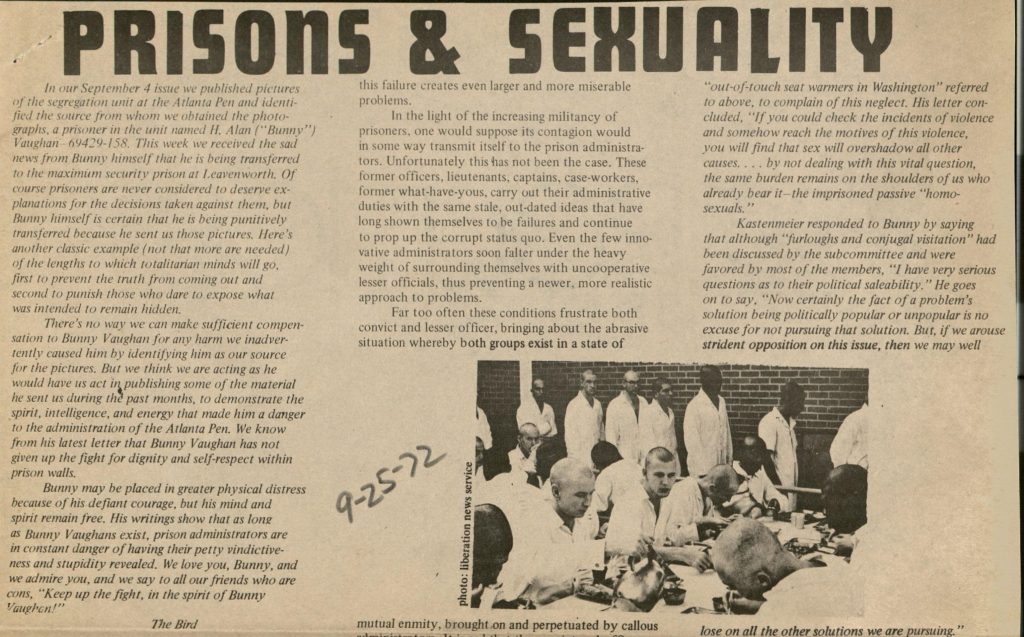Contributed by Benjamin Serby, Visiting Assistant Professor, Adelphi University; 2019-2022 Recipient of a Harry H. Harkins T’73 Travel Grant for Lesbian, Gay, Bisexual, and Transgender History
With the assistance of a Harry H. Harkins, Jr., Travel Grant, I visited the Rubenstein Library in the summer of 2019 to carry out research for my dissertation, an intellectual history of the gay liberation movement in the United States in the late 1960s and early 1970s. At the Rubenstein Library, I consulted several collections, including the Atlanta Lesbian Feminist Alliance (ALFA) Archives and the Faith Holsaert papers, with the intention of tracing the reception of certain understandings of “liberation” in the movement through the lives of key activists, the records of organizations, and the extensive print culture that spanned the country during this time.
In the course of my visit, I encountered a surprising number of fascinating documents that were authored by incarcerated queer and trans people who overcame censorship and the threat of retaliation to demand assistance and recognition from activists and readers on the outside. These sources informed an article that I subsequently published in the Journal of the History of Sexuality.[i] One relevant item is a note to readers of the Atlanta underground newspaper Great Speckled Bird, dated September 5, 1972, which explains that a prisoner, H. Alan “Bunny” Vaughan, was being punished by the authorities for having smuggled photographs of the Atlanta Penitentiary’s segregated gay cell block to the newspaper. One of those illicit images accompanies the report, which praises Vaughan for his commitment to “the fight for dignity and self-respect within prison walls.” This document (which, it should be noted, did not appear in a specifically “gay” publication) raises a number of questions about the oppressive and discriminatory conditions faced by queer and trans prisoners, their relationship to the gay liberation movement, and the role of the press—particularly the underground press—as a means of publicizing the struggles of some of the most marginalized members of the LGBT community.


A related document that stopped me in my tracks when I first encountered it is the founding statement of the National Gay Prisoners Coalition (NGPC), an obscure organization that was established at Washington State Penitentiary in Walla Walla sometime in the early 1970s. The undated text calls for the abolition of sodomy laws, demands an investigation into the treatment of queer and trans prisoners, and urges members of the LGBT community to join and support the new organization. Its author, who is listed as C. Chris Wheeler, wrote “for publication” in pen at the top, but it is unlikely that this text was ever published. Prior to visiting the Rubinstein Library, I had seen Wheeler’s name in print on a number of occasions. A transgender inmate at Walla Walla, they published countless open letters in several gay liberationist newspapers between 1970 and 1973 that detailed their mistreatment and that of their fellow inmates, appealed to readers for material and emotional support, and facilitated political organizing among queer and trans prisoners across institutions. The NGPC statement is a testament to the extent of that organizing.
Just as they challenged a largely middle-class movement to extend its solidarities to the poor, the nonwhite, and the incarcerated, materials such as these provoked me to incorporate a much broader array of social actors into my narrative and to realize that the activist and print networks that I was mapping were far more expansive and inclusive than I had initially thought. Still, we are left with only a trace, and many questions remain unanswered. What became of Vaughan? Wheeler? The other Walla Walla prisoners? The NGPC?
[i] Serby, Benjamin. “‘Not to Produce Newspapers, but Committed Radicals’: The Underground Press, the New Left, and the Gay Liberation Counterpublic in the United States, 1965-1976.” Journal of the History of Sexuality, vol. 32, no. 1, Jan. 2023. http://dx.doi.org/10.7560/JHS32101


